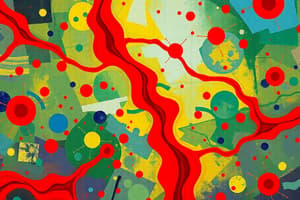Podcast
Questions and Answers
What effect does delayed gastric emptying have on drug bioavailability in patients with diabetes mellitus?
What effect does delayed gastric emptying have on drug bioavailability in patients with diabetes mellitus?
- Decreases bioavailability due to slower absorption (correct)
- Increases bioavailability due to faster absorption
- Has no effect on bioavailability
- Causes immediate dissolution of drugs
When is the best time to take aspirin to ensure optimal absorption?
When is the best time to take aspirin to ensure optimal absorption?
- Immediately before meals
- Two hours after meals (correct)
- With fatty foods
- One hour after meals
What impact do high-protein meals have on certain drugs?
What impact do high-protein meals have on certain drugs?
- They reduce gastric emptying time substantially
- They have no significant impact on drug absorption
- They enhance the absorption of carrier-mediated transport systems (correct)
- They decrease the absorption of all medications
Which drug should be taken away from food to enhance absorption?
Which drug should be taken away from food to enhance absorption?
Which type of foods delay stomach emptying, affecting drug absorption?
Which type of foods delay stomach emptying, affecting drug absorption?
How does the presence of food affect the absorption of itraconazole?
How does the presence of food affect the absorption of itraconazole?
What effect does a high-fat meal have on lipophilic drugs?
What effect does a high-fat meal have on lipophilic drugs?
Which of the following foods should be avoided when taking tetracycline?
Which of the following foods should be avoided when taking tetracycline?
How do ascorbic acid-containing juices affect the absorption of iron supplements?
How do ascorbic acid-containing juices affect the absorption of iron supplements?
What impact does grapefruit juice have on the absorption of felodipine?
What impact does grapefruit juice have on the absorption of felodipine?
What should drugs not be taken with due to the risk of excess stomach acidity?
What should drugs not be taken with due to the risk of excess stomach acidity?
How might a high fiber content meal impact certain drugs?
How might a high fiber content meal impact certain drugs?
Which drug's absorption can be increased by fatty foods?
Which drug's absorption can be increased by fatty foods?
What is one possible outcome of food-drug interactions?
What is one possible outcome of food-drug interactions?
Which stage do the majority of food-drug interactions occur?
Which stage do the majority of food-drug interactions occur?
How does food typically affect drug absorption?
How does food typically affect drug absorption?
What is the term used for the maximum concentration of a drug in the bloodstream?
What is the term used for the maximum concentration of a drug in the bloodstream?
Which of the following describes delayed absorption of a drug?
Which of the following describes delayed absorption of a drug?
Which of the following can contribute to decreased drug absorption?
Which of the following can contribute to decreased drug absorption?
What kind of interactions are primarily observed at the pharmacodynamic level?
What kind of interactions are primarily observed at the pharmacodynamic level?
Which category of absorption interactions results from increased gastric emptying?
Which category of absorption interactions results from increased gastric emptying?
What role does the CYP2C19 enzyme play in drug metabolism?
What role does the CYP2C19 enzyme play in drug metabolism?
How does grapefruit juice affect drug metabolism?
How does grapefruit juice affect drug metabolism?
Which dietary component can enhance the bioavailability of drugs?
Which dietary component can enhance the bioavailability of drugs?
An acidic urine pH prolongs the action of which type of drug?
An acidic urine pH prolongs the action of which type of drug?
Which of the following can directly antagonize the effect of warfarin?
Which of the following can directly antagonize the effect of warfarin?
What impact does malnutrition have on drug metabolism?
What impact does malnutrition have on drug metabolism?
The act of inducing the CYP2C9 enzyme can affect the metabolism of which drug?
The act of inducing the CYP2C9 enzyme can affect the metabolism of which drug?
What can cause quinidine toxicity when combined with antacid intake?
What can cause quinidine toxicity when combined with antacid intake?
Flashcards
Drug-Food Interactions
Drug-Food Interactions
Interactions between food and drugs that can affect drug absorption, metabolism, distribution, and excretion; potentially reducing/increasing drug effectiveness, increasing toxicity, or negatively impacting patient care.
Pharmacokinetic Interactions
Pharmacokinetic Interactions
Food's impact on how the body processes a drug (absorption, metabolism, distribution, excretion); often affecting absorption and metabolism the most.
Pharmacodynamic Interactions
Pharmacodynamic Interactions
Food's impact on how a drug works on the body; usually fewer than pharmacokinetic interactions and mainly involves competing sites.
Delayed Drug Absorption
Delayed Drug Absorption
Signup and view all the flashcards
Decreased Drug Absorption
Decreased Drug Absorption
Signup and view all the flashcards
Cmax
Cmax
Signup and view all the flashcards
tmax
tmax
Signup and view all the flashcards
AUC
AUC
Signup and view all the flashcards
Delayed gastric emptying in diabetes
Delayed gastric emptying in diabetes
Signup and view all the flashcards
Food affecting drug absorption
Food affecting drug absorption
Signup and view all the flashcards
High-fat meal and drug absorption
High-fat meal and drug absorption
Signup and view all the flashcards
Drug solubility and absorption
Drug solubility and absorption
Signup and view all the flashcards
Food's Impact on Absorption
Food's Impact on Absorption
Signup and view all the flashcards
Fiber & Drug Absorption
Fiber & Drug Absorption
Signup and view all the flashcards
Timing of Meals & Drug Absorption
Timing of Meals & Drug Absorption
Signup and view all the flashcards
Calcium & Antibiotics
Calcium & Antibiotics
Signup and view all the flashcards
Vitamin C & Iron
Vitamin C & Iron
Signup and view all the flashcards
Acidic Drinks & Drugs
Acidic Drinks & Drugs
Signup and view all the flashcards
Fatty Foods & Drug Absorption
Fatty Foods & Drug Absorption
Signup and view all the flashcards
Grapefruit Juice Effect
Grapefruit Juice Effect
Signup and view all the flashcards
CYP Enzyme Induction
CYP Enzyme Induction
Signup and view all the flashcards
CYP Enzyme Inhibition
CYP Enzyme Inhibition
Signup and view all the flashcards
Piperine and Bioavailability
Piperine and Bioavailability
Signup and view all the flashcards
Urine pH and Drug Excretion
Urine pH and Drug Excretion
Signup and view all the flashcards
Food-Induced Antacid Toxicity
Food-Induced Antacid Toxicity
Signup and view all the flashcards
Vitamin K and Warfarin
Vitamin K and Warfarin
Signup and view all the flashcards
Study Notes
Basics of Pharmacology & Nutrition
- Food and drug disposition is a key area of study in pharmacology.
- The objectives of the lecture are to describe effects of nutrition on drug pharmacokinetics and pharmacodynamics, and vice versa.
- Food-drug interactions can alter drug effects, causing either therapeutic failure or increased toxicity.
Objectives
- Students should be able to describe the effect of nutrition on drug pharmacokinetics and list examples.
- Students should be able to describe the effect of nutrition on drug pharmacodynamics and list examples.
- Students should be able to describe the effect of drugs on food pharmacokinetics and list examples.
Food-drug Interactions
- Food-drug interactions can reduce or increase the effect of a drug, leading to therapeutic failure or increased toxicity.
- They can adversely affect patient care, contribute to morbidity, and prolong treatment time or hospitalization.
- Food can affect drug absorption, metabolism, distribution, and excretion.
- Drugs can affect food absorption, metabolism, distribution, and excretion.
- Drug side effects can impact food intake and nutrient absorption.
- Certain foods and drugs can create unhealthy effects when combined.
Types of Food-Drug Interactions
- Food-drug interactions can occur at the pharmacokinetic or pharmacodynamic level.
- Most interactions related to pharmacokinetics happen at the absorption (or the stage of absorption and metabolism) step.
- Few pharmacokinetic interactions happen at the pharmacodynamic level (inhibition/stimulation of enzymes, competition at binding sites).
- A list of examples of drugs and their food recommendations is available.
Effects of Food on Drug Absorption
- Food can affect both the rate and extent of drug absorption from the gastrointestinal tract.
- Absorption interactions can be:
- Reduced (extent)
- Delayed (rate)
- Increased (extent)
- Accelerated (rate)
- No effect
- Delayed absorption typically results from slower gastric emptying and/or increased gastric pH. Pharmacokinetically, delayed absorption manifests as decreased Cmax and a longer tmax, but overall extent of absorption (AUC) is usually unaffected.
- Decreased absorption can occur due to certain disease states like diabetes mellitus and inflammatory bowel diseases.
- Examples include aspirin and Isoniazid, where food reduces the rate of absorption.
Absorption interactions:
- Increased or accelerated absorption is seen when absorption is increased from the delayed gastric emptying and increased secretion of bile salts. Example: cyclosporine, halofantrine, griseofulvin. The transport system can also be upregulated by high-protein meals.
- Food-induced malabsorption of drugs: Fatty foods or low fiber foods tend to delay stomach emptying (2hrs), leading to reduced absorption. E.g., Griseofulvin & otlipraz (enhanced absorption & bioavailability after high-fat meal), Ascorbic acid enhances iron absorption. Carbonated drinks or acid juices enhance drug dissolution in the stomach. Tetracyclines can form insoluble complexes with calcium, magnesium, and aluminum.
Factors Alter Absorption
- Characteristics of the drug (e.g., physical and chemical properties, like pKa, molecular weight, etc.). The absorption of Itraconazole is increased by the presence of food but not for fluconazole. The enantiomer(R-to-S) of ibuprofen can be affected by food.
- Characteristics of the meal (e.g., size, composition and fat content, high-fiber content, timing relative to meal). Ex: Bioavailability of lipophilic drugs increase with a high-fat diet, as it results in increased drug solubility or bile secretion.
- Examples: Grapefruit juice can increase bioavailability of felodipine, calcium in milk and milk products reduces the absorption of tetracycline, ascorbic acid in orange juice increases absorption of iron supplements. Drugs should not be consumed with extremely acidic and/or highly carbonated drinks.
Effects of Food on Drug Metabolism
- Various dietary components can influence drug metabolism, including dietary protein, cruciferous vegetables, charcoal-broiled beef (containing polycyclic aromatic hydrocarbons and methylxanthines).
- Malnutrition can alter hepatic metabolism and reduce elimination of conjugates and renally excreted drugs.
- Cytochrome P450 enzymes play a vital role in drug metabolism. Food components can act as inhibitors or inducers of these enzymes, potentially affecting drug metabolism and effectiveness, leading to side effects.
- Examples: Garlic (inhibits CYP2C19, increasing levels and side effects of Omeprazole & Diazepam); Broccoli (induces CYP2C9, affecting drugs like warfarin & tolbutamide).
- Black pepper's active compound, piperine, enhances the bioavailability of certain drugs by inhibiting enzymes.
Food-initiated Alteration of Drug Excretion
- Changes in urine pH due to food can impact the excretion rates of weak acids and bases
- A drug in a unionized state can diffuse from urine back into the bloodstream.
- This is prolonged when the urine is acidic (e.g., prolonged action of acidic drugs).
- Antacid intake with quinidine can cause quinidine toxicity due to the change in urine pH to alkaline.
Pharmacodynamic Interaction
- Vitamin K-rich food intake can directly antagonize the effect of warfarin.
- Avocado intake, potassium-rich foods (bananas, spinach), and food components competing with levodopa (for transporters in Parkinson's disease) can cause pharmacodynamic interactions, potentially resulting in adverse effects.
Effect of Drugs on Food
- Drugs can affect appetite (increase or decrease).
- Drugs can alter nutrient absorption, metabolism or excretion (e.g., laxatives, antacids).
- Some drugs can lead to nausea, vomiting (e.g., cancer drugs), or diarrhea (e.g., antibiotics like amoxicillin).
Summary Examples
- Summary tables are available that detail changes in physiology, potential drug effects, and examples related to drugs commonly involved.
Studying That Suits You
Use AI to generate personalized quizzes and flashcards to suit your learning preferences.




